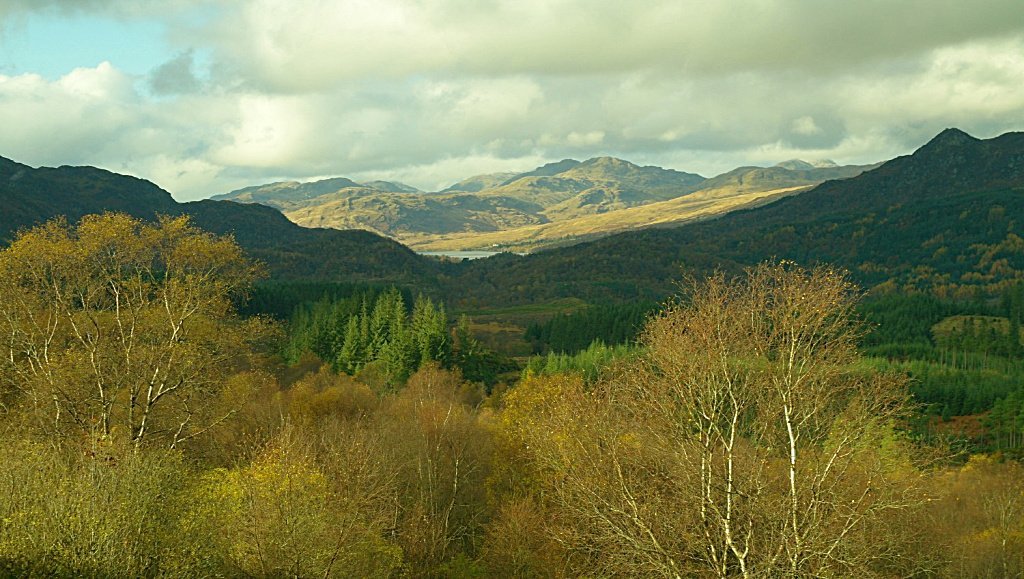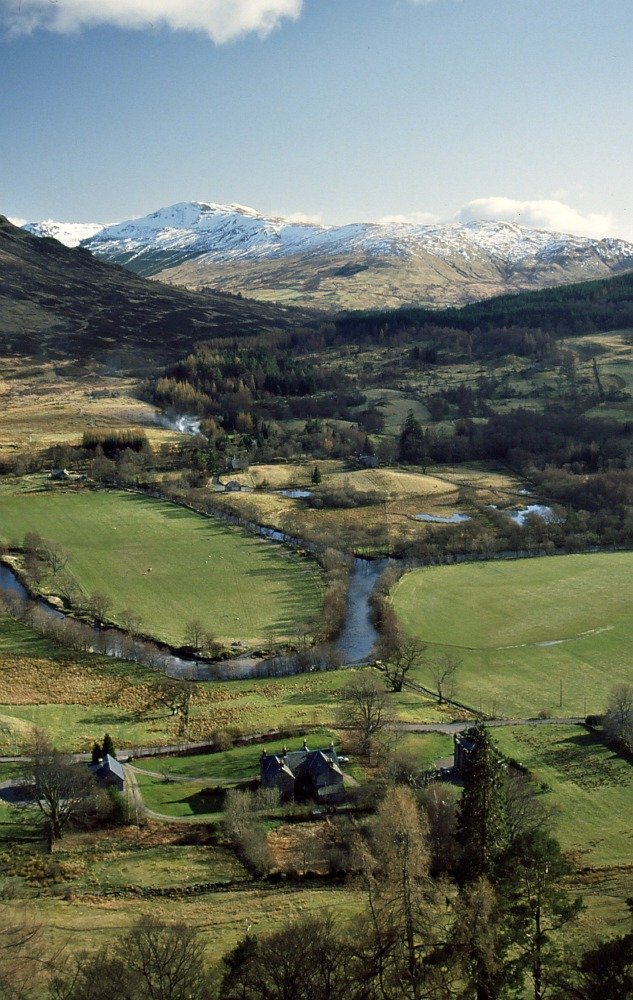So what are and where are the Trossachs? They are the nearest attractive Scottish Highland scenery to Edinburgh & Glasgow. (These days, give yourself an hour’s travel time.) Sir Walter Scott made them famous – and they’ve been popular ever since, because they seem the ‘distilled essence’ of Highland scenery.
Even folk who know little about Scotland have probably heard of the Trossachs, along with Loch Lomond. The Trossachs as a tourism destination has been enjoyed for many generations.
In the early years of the 19th century the area received a substantial boost as the result of the commercial sense of one of Scotland’s best-known writers.
Though greatly out of fashion today, Sir Walter Scott was all the rage as a modern novelist and poet in the early 19th century, with The Border Minstrelsy, The Lay of the Last Minstrel and Marmion already in print.
Scott and The Lady of the Lake
But it was the publication of Scott’s dramatic verse-narrative The Lady of the Lake in 1810 that assured maximum publicity for the shaggy Trossachs landscape on the edge of the Highland line.
Sir Walter Scott’s first acquaintance with the Trossachs was in 1790 when he was a legal apprentice. He visited the area along with an armed guard in order to enforce a legal instrument against some of the local Maclarens.
From the escorting sergeant he heard tales of Rob Roy Macgregor, the local Robin Hood. These stories of bravery – many of them true – set amid wild Highland scenery, fired his imagination.
Following on from the popularity of The Lady of the Lake, his own novel on Rob Roy, published in 1816, added even more landmarks to the Trossachs literary landscape.


You see, that’s the Trossachs for you. Before you are aware of it, you’re writing stuff like ‘a light dusting of snow’ and in the heart of the Trossachs, looking westwards towards a glint of Loch Katrine with Ben An, to the right, in shadow.
You can’t help it. You just go all soppy-doo-dah and poetic hereabouts. It brings out the Romantic in you…
The Tourists Arrive In The Trossachs
Yet Sir Walter was not the first to draw attention to the beauties of the Trossachs.
As a reaction against the order and symmetry of the mid-18th century’s neo-classicism, a taste for Romance had already sprung up by the end of the century, in art, literature – and landscape.
The ‘Cult of the Picturesque’ was already established in England – notably in the English Lake District – and the reputation of the craggy beauty of the Trossachs spread south of the border.
As early as 1794, the local minister in Callander wrote that:
‘The Trossachs are often visited by persons of taste, who are desirous of seeing nature in her rudest and unpolished state.’

Amongst these early enthusiasts was a certain Hon. Mrs Murray of Kensington. She ‘did’ the English Lake District and then turned her attention to the Trossachs, publishing a description in her travel guide ponderously entitled (deep breath, new paragraph…)
‘A Companion, and useful guide to the beauties of Scotland, to the Lakes of Westmorland, Cumberland and Lancashire….to which is added a more particular Description of Scotland, especially that part called the Highlands’.
This early travel guide was published in 1798. With her grand coach and horses, Mrs Murray mounted an impressive expedition: via Callander, Lochs Venacher and Achray, then through the rough track (as it was then) in the heart of the Trossachs, to Loch Katrine.
She then was rowed about the loch and she also scrambled along the equally rough track by the side of the loch today replaced by the levels of Scottish Water’s road.
Afterwards, her party returned to Callander, passing below the little peak of Ben An.
Thus even before Sir Walter’s work, the area was receiving an annual pilgrimage of adventurous folk, encouraged, no doubt by the works of local champions such as the now obscure Strathyre born poet Alexander Campbell.
To today’s readers his poetry is, frankly, dire but his Journey from Edinburgh (c.1802) contains further glowing descriptions of the Trossachs and a dramatic verse narrative about ten years ahead of The Lady of the Lake.

The Romantic Poets Loved The Trossachs
Then, hard on Campbell’s heels came the English Romantic Poets. William Wordsworth, accompanied by his sister Dorothy, and by Samuel Taylor Coleridge, visited Loch Katrine (and many other places besides) in 1803, the first of three trips to Scotland.
Dorothy Wordsworth’s Journal describes the interiors of some of the simple accommodation they found there. (It’s all just a teensy bit patronising in places.)
Her brother William was, unavoidably, moved to verse. Poems inspired by the visit include: To a Highland Girl (at Inversnaid); Stepping Westward’(along Loch Katrine); The Solitary Reaper (at Balquhidder), and Rob Roy’s Grave.
The Rob Roy poem is particularly interesting as it was written following a visit to Clan Gregor graves by the shores of Loch Katrine. These can still to be seen today, though you must walk or cycle several miles round the loch to Portnellan.
Wordsworth thought Rob Roy was buried there, but the real grave at Balquhidder has now become a pilgrimage site of its own.

Just above is a picture from the westerly edge of the Trossachs as they run towards Loch Lomond.
This is one of my favourite views in the Trossachs in spite of being eaten alive by clegs and midges as I took the picture.
Glaciation in The Trossachs
Look out: here comes a geological aside…
In the picture, the Arrochar Alps show their distinctive profile. But what to note is that Loch Lomond lies out of sight in a deep trough between Loch Arklet and the mountains on the horizon. Loch Arklet fills a ‘hanging valley’.
Referring to the pic again, a glacier, long ago, ran from right to left, and created the trench in which Loch Lomond now lies. That’s why there is a waterfall at Inversnaid, where Arklet’s waters tumble into Loch Lomond.

Now where was I before I came over all glacial?
Literary types flocked to The Trossachs
Oh yes, describing what happened after Sir Walter Scott created The Lady of the Lake, a 19th-century tourist board’s publicity dream.
A succession of literary figures followed after him, including James Hogg, the Ettrick Shepherd, then later, Charles Dickens, Jules Verne and Gerard Manley Hopkins of Inversnaid the poem fame.
Many other creatives paid their respects, painters and lesser poets, along with the hordes of visitors, so that by the second half of the 19th century, the ‘tourism infrastructure’ had to be expanded by way of inns and coaches, railways and steamers.


The scenery was by then regarded as a source of ecstasy. Some descriptions were completely over the top.
For example, in The Beauties of Scotland published by the North British Railway Company in 1914, we are told that:
‘The beauties of the Trossachs Tour – the most entrancing single day’s journey in the two hemispheres – prompt rapture, with a capital ‘R’, suggest a whirl of laudatory adjectives, and almost demand….that the glories be outlined in poesy.’
To which I am tempted to say – get a grip. The scenery is fine, certainly, but it’s hardly on a grand scale.
And the railways were just one source of ‘tourism literature’ about the area. Guidebooks with Trossachs views, as pictured here, remained popular for generations.
In 1932, the greatly improved ‘Duke’s Road’ opened beyond Aberfoyle, part of a switch in emphasis towards road based touring which continues right to the present day.
(Though I’d like to persuade you to get out of the car and take a cruise on Loch Lomond. Follow that link too for some more information on the heyday of integrated transport allowing easy tours of the area.
These used connections such as that at Stronachlachar Pier where, even today, the steamer Sir Walter Scott still calls.)
The writer HV Morton in his timeless In Search of Scotland has a famously whimsical passage on The Trossachs.
Loch Katrine: Scotland ‘boiled down to its very essence’
He complains about travelling the length of Scotland and suddenly finding the area around Loch Katrine as ‘the whole thing in concentrated form, boiled down to the very essence…..they are definitely unfair and should be abolished in the interests of more distant places.’
And that, of course, returns full circle to the most important factor in working out why so many folk visit this area.
Not only were the landscapes just sufficiently grand and wild enough to inspire these early tourism pioneers, without being too fearful and intimidating, but they had one further advantage. They lay comparatively near centres of population.

The Trossachs made a convenient tour from the crowded cities of the central belt of Scotland. At the risk of offending its sentimental fans, the same situation perhaps applies to Loch Lomond.
Would the lyric ‘the bonnie, bonnie banks of Loch Assynt’ be as well-known?
To be sentimental about a place, you and preferably as many others as possible need to see it without too much difficulty in the first place.
The Trossachs loop
The situation today still echoes the early times in some respects. Day-trippers do the Trossachs loop: Callander to Brig o’ Turk and on to Loch Katrine.
Then up the hill and over the Duke’s Road to Aberfoyle, much as they have done for generations. (Come to think of it, that’s the Edinburgh-centric way – probably Glasgow folk start at Aberfoyle!)
As well as Aberfoyle, the main gateway to the Trossachs is Callander, a town that always seems busy, with some good places for a pub lunch and some high quality accommodation.
All over the area, the Forestry Commission have waymarked the uplands with walking trails – and even their own car-trail for those thirled to the four-wheeled monster.
The Commission also happily explains its work in the area, which is blanketed by the Queen Elizabeth Forest Park, in its own visitor centre, perched above Aberfoyle, itself the southern gateway to the Trossachs.
What Does The Word ‘Trossachs’ Mean?
Finally, no discourse upon the Trossachs is complete without a stab at what the word means. It’s been a topic of discussion in all kinds of guidebook, practically from the days of the first tourists.
Dorothy Wordsworth had a go at it in ‘A Tour in Scotland 1803’. There she says‘ I believe the word Trossachs signifies’ “many hills”: it is a name given to all the eminences at the foot of Loch Ketterine, and about half a mile beyond.’
Sir Walter Scott sometimes spelt the word as ‘Trosachs’ while in ‘Observations on a Tour through the Highlands of Scotland’ by Thomas Garnett, 1800 there is an ‘Account of the Drossacks’.
The Bristly Country – what?
‘The bristly country’ is another favourite translation and the Rev Patrick Graham – a minister in Aberfoyle – in his ‘Sketches of Perthshire’ (1806) was the first to suggest this meaning.
Dutifully, generations of guidebook writers repeated ‘the rough or bristled territory’, even though Graham gave no explanation or suggested a Gaelic word to support his interpretation.
Trossachs may also derive from an old Gaelic word trasdaichean or troiseachan, which, though used in the plural, may mean a transverse glen joining two others – though this hardly fits the topography of the narrow pass that leads west to Loch Katrine and is often taken to be the heart of the Trossachs.
However, some authorities say the word simply means a crossing place (that is, between lochs Achray and Katrine).
Finally, here’s a very popular yet low-cost option if you want to stay in the Trossachs.
Books on the Trossachs? What a choice!